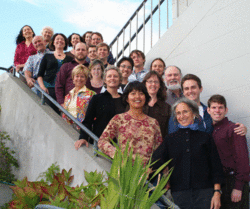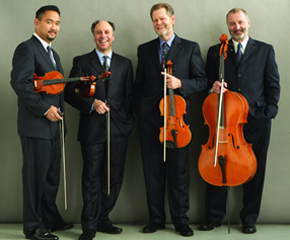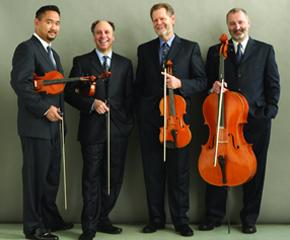
The San Francisco Choral Artists, always adventuresome in their support of new music, are not resting on their laurels. Director Megan Solomon has embarked with them on a new venture, a collaboration with the Alexander String Quartet, and the result was a wonderful concert Saturday night at St. Mark’s Lutheran Church in San Francisco.
Three works commissioned by the Choral Artists, plus a fourth written by their current composer in residence, Richard Felciano, were premiered. First on the program was Winter Light by Michael Gandolfi, set to two poems by Amy Lowell. The quartet began and ended “Falling Snow” with sounds of falling snow, and underlined the “ice and fire” in the opening lines of “Opal” with a strong cello pizzicato set off against a flickering tremolo in the upper instruments. Voices were combined in imaginative ways, alternating and combining women and men, and passing phrases from section to section.
From Gandolfi’s tonal settings the chorus moved on to Felciano’s dissonant a cappella Dawn, set to an excerpt from “The Sun Rising” by John Donne. Equally expressive in both musical styles, the chorus entered enthusiastically into Donne’s protest against the rising sun, which brings unwelcome end to a night of love. Felciano’s setting begins with a “scream” from the women and goes on to have considerable fun with the kinds of boring people who thrive in daylight.

Then it was on to a homophonic elegy by Beethoven. The quartet began with gorgeous playing, and the singers joined them in a lovely performance. In German as well as in English, the singers are moved by both words and music. It shows in their faces.
Stephen Leek’s a cappella Hollow Stone abounds in stunning vocal writing. A wordless beginning builds up powerful dissonances and includes impressive “toning” — singing a single oo with a unison so perfect that a spray of harmonics emerges, from both individual and combined voices. This sound continues as background to words beginning in the strong alto section. The text (from Randolph Stowe’s poem “Sleep”) contrasts the nitty-gritty grind of daytime life with the restorative power of sleep: “Sleep, who are silence, make me a hollow stone.” A rising motif against a unison drone built to a terrific forte and ebbed to a pianissimo. More toning, humming, and a quiet finish. The piece is extraordinary, as was the performance.
The Choral Artists sang four quartets by Brahms (Opus 92), and the Alexander Quartet played the piano part, transcribed by first violinist Zakarias Grafilo. Brahms’ vocal writing is eminently singable, and how this chorus loves to sing! Megan Solomon herself had provided written translations for the program, and it is easy to see, from the quality of her writing, what an important contribution she makes to the singers’ love of words. (From the Quibble Department comes the suggestion that “Spätherbst” looks more like late fall than late spring.) The audience was treated to some purely instrumental Brahms by the Alexanders. It is a great pleasure to hear a program that features new music but combines it with music from other eras.
Deadset on a New Life
In 2006, a group of men from Senegal set out in a boat, seeking a better life. Their boat drifted across the Atlantic, and 11 dead men were discovered in it. One had written a farewell letter to his family as he died. Christopher Marshall’s work for solo tenor accompanied by chorus, This Big Moroccan Sea, is a setting of that letter. It was given a restrained, tender performance by Devin Caughy and his fellow singers.
Veronika Krausas wrote one of the commissioned pieces, language of the birds, setting five fragments of poems by Lawrence Ferlinghetti. Solomon called it “quirky” — an apt description — and the singers had a good time with it. The birds involved were respectively located on treetops, a person’s shoulder, and another person’s head. Various combinations of chorus and quartet — including an ABA form with the quartet on the A sections and the chorus between them, and using a spoken part over a seven-note ostinato and choral accompaniment — made the piece an effective combination of singers and strings.
The third commissioned piece was Clair de Lune by Paul Chihara, a setting of the composer’s English paraphrase of Verlaine’s poem. The paraphrase was wordier than the original French, and certain words were repeated here and there, with the result that the text was difficult to hear and follow. (In the words of the young Jerry Brown, “More is less.”) In certain well-known settings of Verlaine’s poem, every word counts, and every sound is luscious.
This was a marvelous concert, and you have two more chances to hear it: next Saturday in Oakland and Sunday in Palo Alto. Or if, by bad luck, you are otherwise occupied, you will have to wait for the recording.

